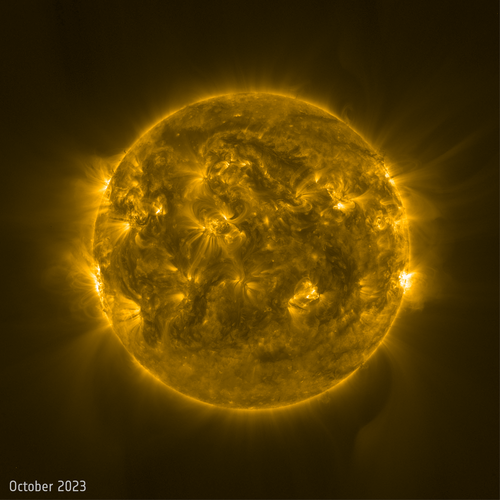See how the Sun changed between February 2021 and October 2023. As the Sun approaches the maximum in its magnetic activity cycle, we see more brilliant explosions, dark sunspots, loops of plasma, and swirls of super-hot gas.
The Sun goes through a cycle of activity that lasts around 11 years. It is caused by the ‘solar dynamo’, the process that generates the Sun’s magnetic field. At the beginning of this cycle (the solar minimum) there is relatively little activity and few sunspots. Activity steadily increases until it peaks (the solar maximum) and then decreases again to a minimum.
The most recent solar minimum was in December 2019, just two months before Solar Orbiterlaunched. The spacecraft’s early views (left) showed that in February 2021 the Sun was still relatively calm.
We are now approaching solar maximum, which is expected to occur in 2025. Solar Orbiter’s more recent views, taken during a close approach to the Sun in October 2023 (right), show a striking increase in solar activity. This adds weight to recent theories [paper 1, paper 2] that the maximum could arrive up to a year earlier than expected.
Solar Orbiter will help us predict the timing and strength of solar cycles. Although notoriously tricky, this is vital because solar activity can seriously affect life on Earth; extreme eruptions can damage ground-based electricity grids and disable orbiting satellites.
The images were taken by Solar Orbiter’s Extreme Ultraviolet Imager (EUI) instrument. They reveal the Sun’s upper atmosphere, which has a temperature of around a million degrees Celsius. EUI helps scientists investigate the mysterious heating processes that occur in the Sun’s outer regions. Since EUI views the Sun in ultraviolet light, which is invisible to human eyes, the yellow colour is added to help us visualise our changing Sun.
Solar Orbiter is a space mission of international collaboration between ESA and NASA, operated by ESA. The Extreme Ultraviolet Imager (EUI) instrument is led by the Royal Observatory of Belgium.



 Image:
Image: